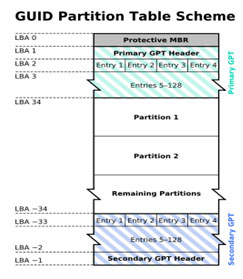GUID: globally unique identifier
What is a GPT disk and GUID Partition Table? How to create a GPT disk?
What is a GPT disk and how to create a GPT disk?
 GPT is the abbreviation of GUID Partition Table. The widespread MBR partitioning scheme, dating from the early 1980s, imposed limitations which affected the use of newer hardware. Intel therefore developed a new partition-table format in the late 1990s as part of what eventually became UEFI. The GPT as of 2010 forms a subset of the UEFI specification.
GPT is the abbreviation of GUID Partition Table. The widespread MBR partitioning scheme, dating from the early 1980s, imposed limitations which affected the use of newer hardware. Intel therefore developed a new partition-table format in the late 1990s as part of what eventually became UEFI. The GPT as of 2010 forms a subset of the UEFI specification.GPT vs. MBR
Compared with MBR disk, A GPT disk can support larger than 2 TB volumes where MBR cannot. A GPT disk can be basic or dynamic, just like an MBR disk can be basic or dynamic. GPT disks also support up to 128 partitions rather than the 4 primary partitions limited to MBR. Also, GPT keeps a backup of the partition table at the end of the disk. Furthermore, GPT disk provides greater reliability due to replication and cyclical redundancy check (CRC) protection of the partition table. It can be used as a storage volume on all x64-based platforms, including platforms running Microsoft Windows XP Professional x64 Edition. Windows Server 2003 SP1 also enables support for GPT in x86 versions of the Windows Server 2003 family.

Disadvantages of MBR disk
MBR disks support only four partition table entries. That is to say, it only allows users to create four primary partitions at most. If more partitions are wanted, a secondary structure known as an extended partition is necessary. Extended partitions can then be subdivided into one or more successive logical disks. Another common practice is to use partitioned or "hidden" sectors to hold specific information. That practice is undocumented and results in severe system problems that are difficult to debug. Over the years, vendor-specific implementations and tools have been released to the public, making support difficult.
Why we need GPT disk?
Compared with MBR disk, GPT disks can grow to a very large size. The number of partitions on a GPT disk is not constrained by temporary schemes such as container partitions as defined by the MBR Extended Boot Record (EBR).
The GPT disk partition format is well defined and fully self-identifying. Data critical to platform operation is located in partitions and not in unpartitioned or "hidden" sectors. GPT disks use primary and backup partition tables for redundancy and CRC32 fields for improved partition data structure integrity. The GPT partition format uses version number and size fields for future expansion.
How to convert MBR disk to GPT disk
Solution 1: Convert MBR disk to GPT disk with EASEUS Partition Master
Solution 2: Convert MBR disk to GPT disk with Windows Disk Management
Solution 3: Convert MBR disk to GPT disk with Diskpart command
------------------------------------------------Source
MBR is the standard partitioning scheme that's been used on hard disks since the PC first came out. It supports 4 primary partitions per hard drive, and a maximum partition size of 2TB.
GPT disks are new, and are readable only by Windows Server 2003 SP1, Windows Vista (all versions), and Windows XP x64 Edition. The GPT disk itself can support a volume up to 2^64 blocks in length. (For 512-byte blocks, this is 9.44 ZB - zettabytes. 1 ZB is 1 billion terabytes). It can also support theoretically unlimited partitions.
Windows restricts these limits further to 256 TB for a single partition (NTFS limit), and 128 partitions.
Only Itanium systems running Windows Server 2003 and Windows Vista systems with an EFI BIOS can boot from a GPT disk. The other operating systems mentioned earlier can use GPT disks as data disks but not boot disks.
For more information on GPT, see Problems with larger than 2TB arrays in the General Storage forum, and see Windows and GPT FAQ for additional information.
-------------------------------------------------
READ: ss64.com/nt/diskpart.html
How to delete GPT Protective Partition
In Windows XP Professional, if you cannot access or modify GPT disk, you can convert a GPT disk to MBR by using the clean command in DiskPart, which will remove all data and partition structures from the disk.
1. You might see S2VR HD 5 Drives in GPT status.
2. Go to DOS command line (click on “Start Menu”, then “Run”, type in “cmd” in textbox, and hit “OK”)
- Type in “DiskPart” in command line.
- Type in “list disk” in command line to show all disks in this machine.
- Use “select” to set the focus to the specified partition, for example “select disk 1″.
- Use “clean” command to remove GPT disk from the current in-focus disk by zeroing sectors.
3. Go back to Disk Management, you can see all S2VR HD disks are “unallocated” now. Right click on disk info, choose “Initialize Disk”.
4. Choose all drives in S2VR HD and initialize them.
Warning: This command will erase all data on the disk, so please backup your data first.
[...] is GPT which WinXP 32 cant read, so if you have sensible data on it copy it elsewhere and use Paul Gu|blog � Blog Archive � How to delete GPT Protective Partition to get the normal older MBR on it or get Vista or WinXP 64bit to be able to read a GPT disk. [...]
To get rid of the GPT Protective Partition without loosing data.



 LibreOffice
LibreOffice Firefox
Firefox
No comments:
Post a Comment